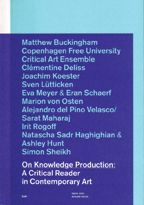 |
On Knowledge Production: A Critical Reader in Contemporary Art, (BAK Critical Reader Series). Edited by Maria Hlavajova, Jill Winder and Binna Choi. Utretch: BAK, Basis voor Actuele Kunst, and Frankfurt: Revolver, 2008.
This critical reader presents diverse, and sometimes opposing, thoughts about art as a vehicle for the production of knowledge—a subject that has come to the fore in contemporary art discussions in recent years.
This book is important for anyone interested in contested topics such as the practice (and relative merits) of artistic research as a way of working, notions of what knowledge actually is and how it relates to art, the cultural and political implications of “knowledge-based economies,” and ideas relating to processes of learning and unlearning. These issues are tackled through a range of contributions by artists, art historians, philosophers and theorists, including Matthew Buckingham, Sarat Maharaj, Irit Rogoff, Simon Sheikh, and Eva Meyer and Eran Schaerf, whose text is aptly titled “What does art know?”
|